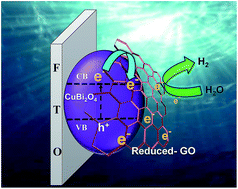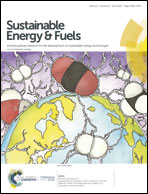Reduced graphene oxide modified CuBi2O4 as an efficient and noble metal free photocathode for superior photoelectrochemical hydrogen production†
Abstract
Photoelectrochemical water splitting (PEC) is considered to be one of the proficient approaches for converting perpetual solar energy into chemical energy. Finding new materials which are earth abundant and economical is crucial in commercializing this technology in future. Herein, we have proposed noble metal free, p-type CuBi2O4 directly fabricated over FTO, overlaid with reduced graphene oxide (RGO). CuBi2O4 with an optimized number of RGO deposition cycles displayed the highest current density, which is ∼2 times higher than that of the bare CuBi2O4 photocathode. An average faradaic efficiency of 91.7% was achieved, indicating that the photocurrent generated in the RGO modified CuBi2O4 photocathode is attributed solely to the water reduction. With RGO modification over CuBi2O4, charge carrier density increases from 3.76 × 1020 cm−3 to 7.92 × 1020 cm−3. A significant increase in carrier density indicates enhanced charge injection as well as separation owing to an efficient charge transfer from CuBi2O4 to RGO through favourable band alignment. Furthermore, open circuit potential decay (OCPD) measurements indicate enhanced charge separation with the introduction of graphene oxide into CuBi2O4.



 Please wait while we load your content...
Please wait while we load your content...